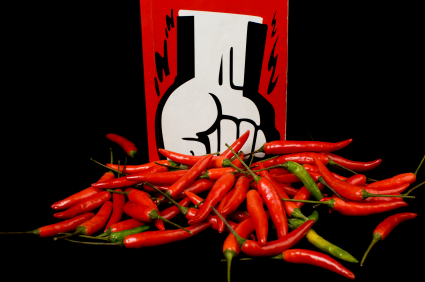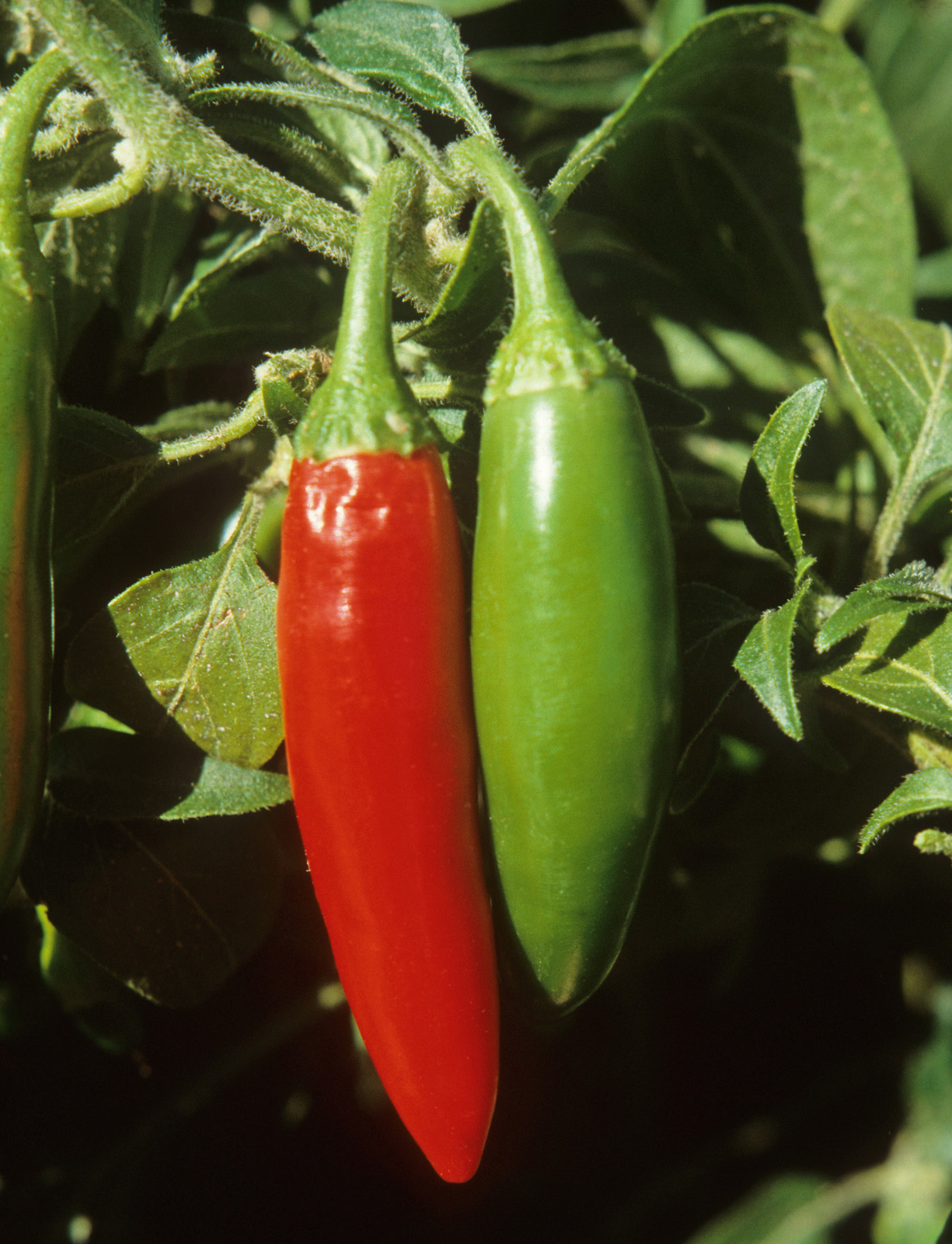by Dave DeWitt
Excerpted from The Chile Pepper Encyclopedia (1998, William Morrow & Co.).
Chile peppers don’t have to be healthy to be fun to eat, but fortunately, they are. In fact, they have quite a long history as a folk remedy for all kinds of ailments, from anorexia to vertigo. Some of the more scientifically recognized medical applications of chile peppers include treatments for asthma, arthritis, blood clots, cluster headaches, post-herpetic neuralgia (shingles), and severe burns.
Chile peppers contain only a few calories (thirty-seven per 100 grams of green chile, about three and a half ounces), and possibly have the ability to burn off those calories and others as well. This intriguing possibility comes from researchers at Oxford Polytechnic Institute in England, who conducted an experiment in TEF, an acronym meaning “thermic effects of food.” Twelve volunteers ate identical 766-calorie meals. On one day, three grams each of chile powder and mustard were added to the meals; on the next day, nothing was added. On the days chile and mustard were added, the volunteers burned between four to seventy-six additional calories, with an average of forty-five.
The researchers concluded that the test was “a possible lead to a different approach to weight reduction,” but also warned that the effect had been demonstrated in only one small test. They also cautioned that six grams (1/5 ounce) of the chile-mustard mixture “may be a large amount for the average American. If you are used to Mexican, Spanish, or Indian food, though, it’s reasonable.”
A possible explanation for the process is the fact that certain hot spices–especially chiles–temporarily speed up the body’s metabolism. After eating, the metabolic rate increases anyway–a phenomenon known as “diet-induced thermic effect.” But chiles boost that effect by a factor of twenty-five, which seems to indicate that increasing the amount of chile in a recipe could reduce the effective caloric content–provided, of course, that one does not drink more beer to counter the added heat.
Another intriguing possibility has been suggested by T. George Harris, who wrote in American Health magazine that chiles stimulate the taste buds but not the sense of smell. Thus they “perk up food without adding fat.” Harris added that he formerly made jokes about hot pepper diets, but now, “over the last couple of years, chile peppers have begun to emerge as the nutritional heroes of the future.”
Most of the research on the nutritional properties of hot peppers has concerned the New Mexican pod types because they are consumed more as a food than a condiment. The long green pods are harvested, roasted and peeled, and are stuffed or made into sauces. Some of the green pods are allowed to turn red on the bush; after harvesting, these red chiles are used as the primary ingredient in red chile sauces. The green chiles are quite high in vitamin C, with about twice the amount by weight found in citrus, while dried red chiles contain more vitamin A than carrots. Vitamin C is one of the least stable of all the vitamins; it will break down chemically by heat, exposure to air, solubility in water, and by dehydration. Vitamin A, however, is one of the most stable vitamins and is not affected by canning, cooking, or time.
A high percentage of vitamin C in fresh green chiles is retained in the canned and frozen products, but the vitamin C content drops dramatically in the dried red pods and powder. Each hundred grams of fresh ripe chile pods contains 369 milligrams of vitamin C, which diminishes by more than half to 154 milligrams in the dried red pods. Red chile powder contains less than three percent of the vitamin C of ripe pods, a low ten milligrams.
The amount of vitamin A dramatically increases as the pod turns red and dries, from 770 units per hundred grams of green pods to 77,000 in freshly processed dried red pods. This hundred&endash;fold rise in vitamin A content is the result of increasing carotene, the chemical which produces the orange and red colors of ripe peppers. The recommended daily allowances for these vitamins are 5000 International Units for A and sixty milligrams for C. These allowances can be satisfied daily by eating about a teaspoon&endash;full of red chile sauce for A and about one ounce of fresh green chile for C.
Each hundred grams of green chile contains less than two&endash;tenths of a gram of fat&endash;&endash;a very low amount. Since no cholesterol is found in vegetable products, peppers are free of it. The fiber content of fresh hot peppers is fairly high (between 1.3 and 2.3 grams per hundred grams of chile), and many of the dishes prepared with them utilize starchy ingredients such as beans, pasta, and tortillas. And the sugar in chiles is in the form of healthy complex carbohydrates.
Fresh green chile contains only 3.5 to 5.7 milligrams of sodium per hundred grams–a very low amount. We suggest that chile peppers can be very useful for the low&endash;sodium dieter. The substitution of hot peppers for salt makes gustatory sense because the pungency of the peppers counteracts the blandness of the meal resulting from salt restrictions. In other words, the heat masks the absence of salt.
However, canned green chile peppers should be avoided because of the salt used in the canning process, which can be over a hundred times the amount in fresh or frozen chiles. For people on a potassium&endash;restricted diet, the opposite is true: canned chiles have one&endash;half the potassium content as fresh ones. Some experts blame this anomaly on the hot lye bath method of removing the tough pepper skins, a technique which provides additional sodium by absorption and reduces the potassium through leaching. It should be noted that some processors have switched to a high&endash;pressure steam treatment to remove skins&endash;&endash;a far more healthy and tasty method.
Chile and Herb Salt Substitute
Use this recipe to eliminate excess salt from your diet or to reduce the amount of sale in many recipes. It tastes the best, of course, when you grow and dry your own herbs, but commercially purchased dried herbs will work also. Try this mixture on baked potatoes, pasta, and vegetables– especially corn on the cob.
4 tablespoons dried parsley
4 tablespoons dried basil
2 teaspoons dried rosemary
1 tablespoon dried tarragon
2 tablespoons dried thyme
1 tablespoon dried dill weed
2 tablespoons paprika
1 teaspoon celery seed
1 teaspoon crushed, dried red chiles such as piquins, or 2 teaspoons New Mexican red chile powder.Place all ingredients in a mini-food processor and blend for 10 seconds or so. Put the mixture into a shaker jar and cover tightly until ready to use.
Yield: 1/2 cup
Heat Scale: Mild to Medium
Note: Try adding 1 tablespoon of pineapple-sage to replace the tarragon.










